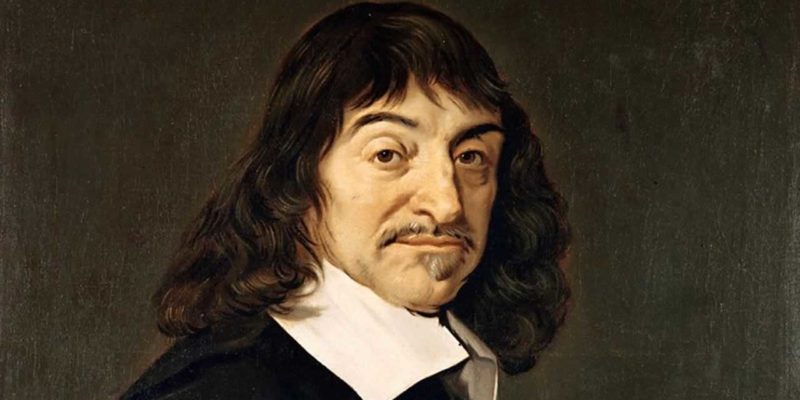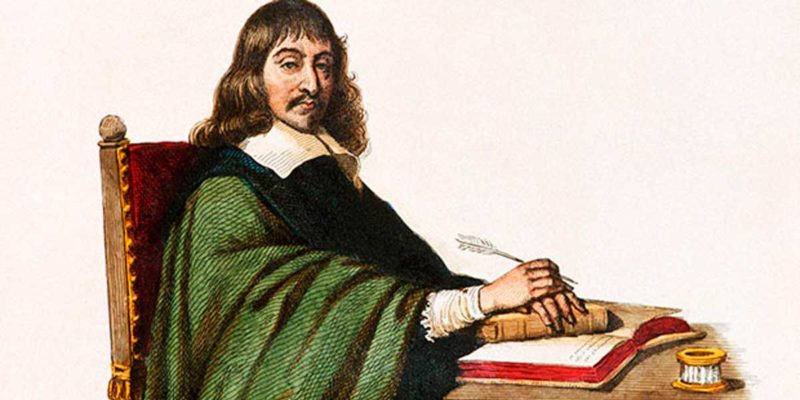We explain who René Descartes was, where he was born, his works and main contributions. In addition, we explore his main characteristics and most famous quotations.

Who was René Descartes?
René Descartes (1596-1650) was a French philosopher, scientist and mathematician, traditionally regarded as the father of modern philosophy, analytic geometry and mechanistic physics.
Descartes was one of the great scientific minds of his time and remains a seminal figure in Western culture today. He is considered an innovator and a disruptor of the methods and theories accepted by the academy at the time, which he helped to rebuild.
Many philosophical works and concepts based on the postulates of Descartes bear the adjective "Cartesian" in reference to the thinker. Whether in metaphysics, theology or epistemology, Descartes is a figure constantly revisited, which is proof that his thought still speaks to us now and continues to exert a profound influence on present-day philosophers.
Among his numerous and varied works are fundamental titles such as Rules for the Direction of the Mind (1628), Discourse on the Method (1637) and Metaphysical Meditations (1641).
- See also: Pythagoras
Life and Education of Descartes
Descartes was born on March 13, 1596 in Touraine (France), nowadays called "Descartes" in his honor. He was the third child of a French family of the lower nobility. His father, Joachim Descartes, was a member of the Parliament of Brittany and his mother, Jeanne Brochard, was the daughter of the mayor of Nantes. At the time of his birth his parents were fleeing Rennes to escape the bubonic plague. Only a few months old, Descartes was orphaned of his mother on May 13, 1597 and was left in the care of his father at his maternal grandmother’s home.
Descartes received early education at the Jesuit Collège Royal Henri-Le-Grand at La Flèche, from the age of eleven to sixteen. Even if he had to follow a special diet for his alleged delicate health, he was highly appreciated by the educational community. From an early age he learned and excelled in physics, scholastic philosophy and mathematics. He also studied Greek and Latin and read authors such as Aristotle, Cicero, Homer and Plato, among others.
In 1614 he entered the University of Poitiers, where he studied medicine and law, earning a Baccalauréat (bachelor's degree) and a Licence (master's degree). After a brief incursion into military life and after having traveled to Denmark and Germany, Descartes returned to France and settled in Paris. He remained there until 1629, when he settled permanently in the Netherlands.
In 1649 Queen Christina of Sweden summoned him to Stockholm, where he died of pneumonia in February of the following year. The cause of his death is often a subject of speculation. Eike Pies, German historian and physician, argues in his book The Murder of Descartes that he was murdered with arsenic poisoning.
Fields of interest of René Descartes
Descartes had a preference for the sciences that flourished during and after the Renaissance, considering himself a Copernican and an atomist, following the studies of Copernicus, Galileo, and Gassendi.
He maintained close correspondence with many thinkers of his time, engaging in frequent discussions on physics, mathematics, and philosophy, his three major fields of work.
His works encompass a wide range of fields. Examples of these are his contributions to geometry, optics, physics, mathematics and philosophy in most of its branches.
Works by René Descartes
Except for a few notes from his youth, Descartes' first surviving work was his Rules for the Direction of the Mind (1701), which was written in 1628 but published posthumously. Other important works published during his lifetime include Discourse on the Method of Rightly Conducting One's Reason and of Seeking Truth in the Sciences, Meditations on First Philosophy, The Search for Truth by Natural Reason and Principles of Philosophy, among others.
Most of his works were written in Latin, as was customary at the time although many were also written in his native language, French. Some of his most fundamental works considered central to Western philosophy continue to be standard texts at universities and schools of philosophy today. These include:
- Discourse on the Method (1637). Originally written in French, it is divided into six parts and narrates Descartes' life story and the circumstances he encountered in order to find a unitary method of knowledge. Here appears the Cartesian or hyperbolic doubt for the first time, which Descartes elaborates. He goes on to expound on the four principles to be followed to arrive at the ultimate truth of things. Truth is characterized as distinct and evident, the two criteria for distinguishing it.
- Meditations on First Philosophy (1641). Originally written in French, the meditations present the philosophical system introduced by Descartes in his Discourse on the Method. Divided into six parts (each one a meditation), the book is a metaphysical elaboration of the Cartesian method of hyperbolic doubt. After an initial meditation in which Descartes rejects the sources of all possible knowledge (the senses and reason), the other five meditations revolve around the possibility of restoring the validity of those same sources to conclude that humans are not always mistaken and can arrive at a distinct and evident truth.
Main ideas of René Descartes

Descartes' philosophical works marked the transition from one era (the medieval world) to philosophical modernity. Most of his works revolve around the criticism of established methods of thought, the construction of a new method to attain truth, the development of hyperbolic doubt (the "methodic doubt") and the ego cogito as the first evident truth.
- Deduction and induction. The method consisted in the application of deductive and inductive reasoning of science and philosophy. These reasonings rejected the Scholastic doctrine, which relied on the views of Ancient masters and on the canonical interpretation of the Scriptures to guarantee truth.
- The existence of God. Though his thought acknowledged the existence of God, many scholars argue that God only appears to avoid problems with the Church. It is undeniable that Descartes lived at a time of censorship and intellectual persecution (as happened with Galileo). However, in the Meditations on First Philosophy, God as the guarantor of truth plays such a crucial role in recovering the world that his presence is inevitable.
- Methodic doubt. Also known as "hyperbolic" doubt (due to its exaggerated nature) or "Cartesian" doubt (in reference to Descartes). Doubt is proposed as a methodological approach in his Discourse on the Method and is later put into practice in Meditations on First Philosophy. Descartes argues that anything that may be subject to doubt must be discarded as certain. Cartesian doubt means to know beyond not merely all reasonable doubt but all possible doubt.
- Ego cogito. Although various precedents can be traced, Descartes is credited as the first to formulate the ego cogito: "I think, therefore I am". This dictum, its meaning, and its utility in the Meditations are still central in philosophical discussions today. Broadly speaking, the ego cogito affirms the presence of the self above all things. The world as extended matter (res extensa), the body and even the senses play a secondary role compared to the evidence and inevitability of the Cartesian ego. Even in doubt, deception or mistake, the existence of the self is indubitable and necessary in order to experience each of these.
Other philosophical ideas and concepts introduced by Descartes include the mind-body dualism, the immortality of the soul, the immanence of ideas, the levels of reality, the physical functioning of the body (which is very close to contemporary understanding) and the origin of the content of dreams, among others.
Contributions of René Descartes in other fields
Descartes’ main contribution to mathematics was the emergence of analytic geometry, since he connected the previously separate fields of geometry and algebra, as well as the formulation of the theory of equations. His contributions to the field were numerous and are related to his method of formulating concepts.
For instance, he introduced the use of the letters of the alphabet as variables, making the distinction between the first letters (A, B, C...) for the known and the last letters (X, Y, Z...) for the unknown.
Furthermore, Descartes introduced the mathematical notation used to indicate powers or exponents and the Cartesian Rule of Signs. Today, we speak of "Cartesian plane" in his honor.
While his contributions to physics were not as significant, optics and mechanics greatly benefited from his thinking. By replacing spiritual values in the works of earlier thinkers with mechanical interpretations, Descartes was able to better approach physical phenomena and thus laid the foundations for the modern scientific method.
Recognition of René Descartes
Descartes' remains were exhumed in 1676 and placed in a copper coffin to be transported to Paris, where they were initially located in the Church of Saint-Geneviève-du-Mont, then in the Panthéon and finally in the Abbey of Saint-Germain-des-Prés. His skull is currently housed in the Museum of Man in the same city. His hometown as well as one of the lunar craters bear his name.
References
- Cottingham, J. G. (1993). A Descartes dictionary. Blackwell Reference.
- Cottingham, J. G. (1995). Descartes. Universidad Nacional Autónoma de México.
- Cottingham, J. G. (1992). The Cambridge Companion to Descartes. Cambridge University Press.
Related articles:
Was this information useful to you?
Yes NoThank you for visiting us :)